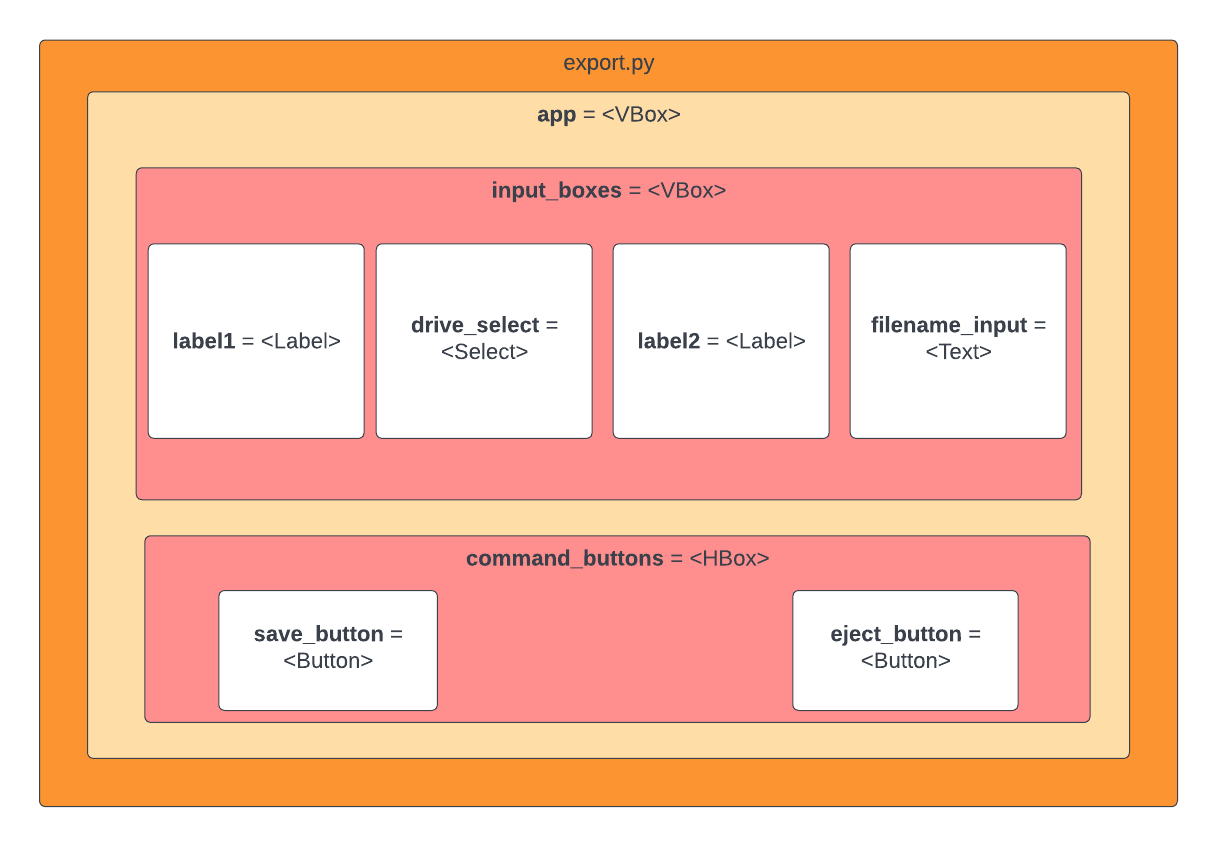webapp.export¶
Widget definition module: Defines UI elements used for exporting recorded data to local or mounted storage devices, including file names and save location.
Use the following code to import and display the widgets defined in this module:
- example:
>>> from webapp import export
>>> display(export.app)
Widget layout¶

Widget objects¶
- webapp.export.app <ipywidgets.widgets.VBox>¶
Module top-level container widget - holds all the widgets defined in the
webapp.exportmodule, which make up the Export tab of the dashboard app.Allows the Export tab to be imported into the dashboard app using the code below:
- Example:
>>> from webapp import export >>> export.app
- webapp.export.drive_select <ipywidgets.widgets.Select>¶
Selection dropdown widget, for selecting desired storage device
- webapp.export.filename_input <ipywidgets.widgets.Text>¶
Text input widget, for entering desired filename
- webapp.export.save_button <ipywidgets.widgets.Button>¶
Button widget, “Save data”
- webapp.export.eject_button <ipywidgets.widgets.Button>¶
Button widget, “Eject disk”
Helper functions¶
- webapp.export.detect_mountpoints()¶
Returns list of mounted storage devices as list of (name, path) tuples.
Detects mounted block storage devices under
/media/pi/directory, then returns them as a list of tuples, in the format(name, path), wherenameis the mountpoint name andpathis the absolute path to the mountpoint.- Returns:
[(name, path), ...]- Return type:
list(tuple(str, str)))- Example:
>>> print(detect_mountpoints()) [('SanDisk', '/media/pi/SanDisk')]
- webapp.export.save_click(b)¶
Event handler for save_button.
The callback function for the save_button widget. Saves data to mounted storage device or local storage, depending on selection in drive_select widget and filename in filename_input widget.
- Parameters:
b (ipywidgets.widgets.Button) – Button widget that triggers the event
- webapp.export.eject_click(b)¶
Event handler for eject_button.
The callback function for the eject_button widget. Ejects the selected mounted storage device, specified by the drive_select widget.
- Parameters:
b (ipywidgets.widgets.Button) – Button widget that triggers the event
Code listing¶
"""Widget definition module: Defines UI elements used for exporting recorded
data to local or mounted storage devices, including file names and save
location.
Use the following code to import and display the widgets defined in this
module:
:example:
>>> from webapp import export
>>> display(export.app)
"""
from ipywidgets.widgets import VBox, Layout, Label, Select, Text, Button, HBox
from datetime import datetime
import numpy as np
import os
try:
from webapp.shared import appState
except ImportError:
appState = None
MOUNTDIR = '/media/pi/'
LOCALDIR = '/home/pi/data/'
# Utility functions:
def detect_mountpoints():
"""
Returns list of mounted storage devices as list of (name, path) tuples.
Detects mounted block storage devices under ``/media/pi/`` directory, then
returns them as a list of tuples, in the format ``(name, path)``, where
``name`` is the mountpoint name and ``path`` is the absolute path to the
mountpoint.
:return: ``[(name, path), ...]``
:rtype: ``list(tuple(str, str)))``
:Example:
>>> print(detect_mountpoints())
[('SanDisk', '/media/pi/SanDisk')]
"""
if os.path.exists(MOUNTDIR):
mountpoints = [(dir, "/media/pi/" + dir) for dir in os.listdir(MOUNTDIR) if dir != "CIRCUITPY"]
else:
mountpoints = [("data", "/home/pi/data")]
return mountpoints
def save_click(b):
"""Event handler for save_button.
The callback function for the save_button widget. Saves data to mounted storage device or local
storage, depending on selection in drive_select widget and filename in filename_input widget.
:param b: Button widget that triggers the event
:type b: ipywidgets.widgets.Button
"""
path = drive_select.value + filename_input.value
with open(path,'w') as f:
for key,val in appState.runs[-1].items():
f.write(f'{key}: ' + ', '.join(np.char.mod('%.2f', val)) +'\n')
def eject_click(b):
"""Event handler for eject_button.
The callback function for the eject_button widget. Ejects the selected mounted storage device,
specified by the drive_select widget.
:param b: Button widget that triggers the event
:type b: ipywidgets.widgets.Button
"""
pass
# Widget definitions:
## Text label
label1 = Label('Mounted storage drives:')
drive_select = Select(
options=[('Local storage', LOCALDIR)] + detect_mountpoints(),
value=LOCALDIR,
disabled=False,
layout=Layout(width='87.5%', height='29.15%',margin='0 0 0 0')
) #: Selection dropdown widget, for selecting desired storage device
label2 = Label('Filename:') #: Text label
filename_input = Text(
value='DATA-{}.csv'.format(datetime.now().strftime('%Y-%m-%d-%H-%M-%S')),
disabled=False,
layout=Layout(width='87.5%')
) #: Text input widget, for entering desired filename
input_boxes = VBox(
children=(label1, drive_select, label2, filename_input),
layout=Layout(width='90.5%', height='75%', margin='0 0 0 0')
) #: Vertical box widget, containing above widgets
save_button = Button(
description='Save data',
disabled=False,
button_style='success',
tooltip='Save readings to mounted storage drive',
icon='download'
) #: Button widget, "Save data"
eject_button = Button(
description='Eject disk',
disabled=False,
button_style='success',
tooltip='Eject mounted storage drive',
icon='eject'
) #: Button widget, "Eject disk"
## Register save_click() function as event handler for save_button
save_button.on_click(save_click)
## Register eject_click() function as event handler for eject_button
eject_button.on_click(eject_click)
# Horizontal box widget, containing button widgets
command_buttons = HBox(
children=(save_button, eject_button),
layout=Layout(width='90.5%', height='21%', margin='0 0 0 0')
)
app = VBox(
children=(input_boxes, command_buttons),
layout=Layout(width='94%', height='100%', margin='0 0 0 0')
)
"""
Module top-level container widget - holds all the widgets defined in the
:mod:`webapp.export` module, which make up the Export tab of the dashboard app.
Allows the Export tab to be imported into the dashboard app using the code
below:
:example:
>>> from webapp import export
>>> export.app
"""